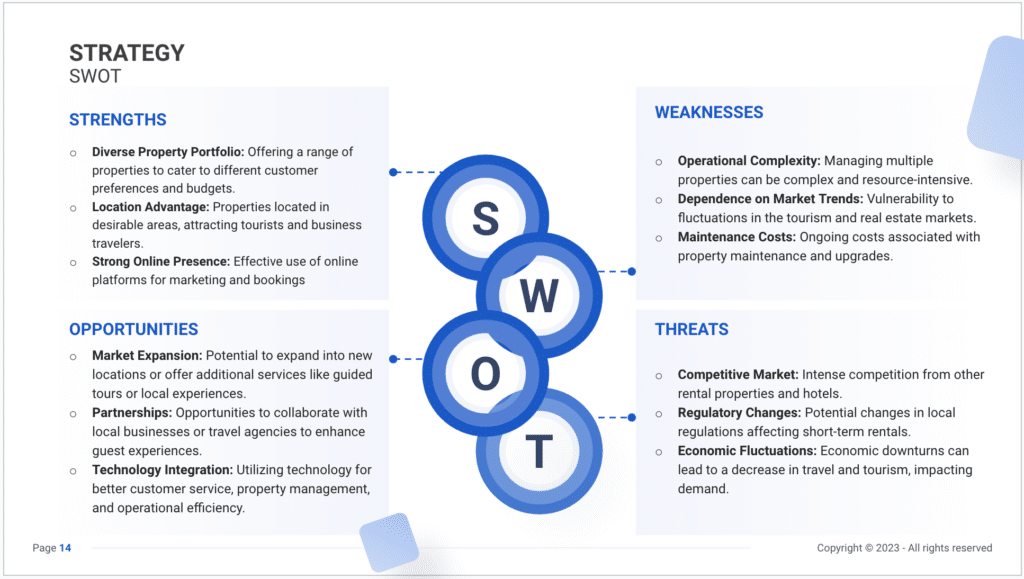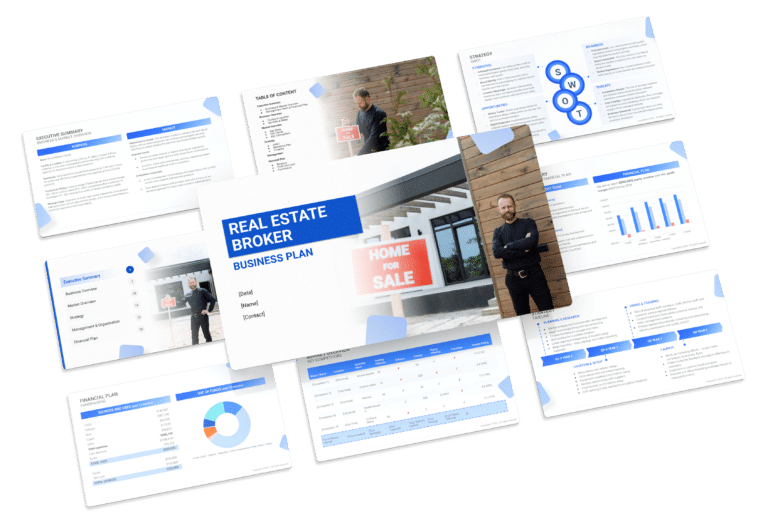SWOT for a Property Rental Business (Example)

Integral to formulating a business plan for a property rental company is the SWOT analysis. SWOT (Strengths, Weaknesses, Opportunities, Threats) aids property proprietors in evaluating both internal and external factors impacting their business.
Strengths and weaknesses, encompassing property conditions and operational efficacy, are within the proprietor’s realm of control. Opportunities and threats, including market trends and economic shifts, are external dynamics requiring careful consideration.
This guide will scrutinize instances of strengths and weaknesses, providing invaluable insights to empower property owners in preparing their business plans.

Strengths
Discover the inherent strengths that position Property Rental Services as indispensable players in the real estate realm.
- Stable Income Streams: Property rentals provide a consistent and stable income, making them an attractive investment for long-term financial growth.
- Example: Offering well-maintained properties with desirable amenities ensures tenant satisfaction, contributing to long-term lease agreements and stable income.
- Diversification of Portfolio: Owning a variety of properties allows for portfolio diversification, mitigating risks associated with fluctuations in specific markets.
- Example: Investing in properties across different neighborhoods or catering to various rental markets broadens the portfolio and minimizes vulnerability to localized economic downturns.
- Property Appreciation Potential: Over time, real estate properties tend to appreciate, offering the potential for substantial capital gains.
- Example: Strategically choosing properties in areas with forecasted growth or urban development increases the likelihood of long-term appreciation and higher resale value.
- Tax Advantages: Property owners often benefit from tax advantages, including deductions for mortgage interest, property taxes, and depreciation.
- Example: Engaging with tax professionals to maximize available deductions or taking advantage of tax credits for energy-efficient property upgrades enhances overall financial returns.
Weaknesses
Identifying weaknesses is paramount to overcoming challenges and ensuring sustained growth in Property Rental Services.
- Market Volatility and Economic Fluctuations: Property values and rental demand can be influenced by economic downturns, affecting investment returns.
- Example: Implementing contingency plans, such as a robust marketing strategy during economic downturns, helps maintain tenant retention and attract new lessees.
- Maintenance and Operational Costs: Property owners bear the burden of maintenance costs, impacting profitability.
- Example: Implementing proactive maintenance schedules or exploring cost-effective renovations can reduce long-term operational expenses and enhance property value.
- Regulatory Compliance Challenges: Evolving regulations and compliance requirements can pose challenges for property owners, leading to potential legal issues.
- Example: Regularly updating lease agreements, staying informed about local housing laws, and seeking legal counsel mitigate compliance risks and ensure smooth operations.
- Dependency on Local Real Estate Trends: Overreliance on specific local real estate trends can expose property owners to risks associated with market fluctuations.
- Example: Diversifying investments by exploring properties in emerging neighborhoods or cities safeguards against localized market downturns.
Opportunities
Identifying and capitalizing on opportunities can position Property Rental Services for sustained success in the competitive real estate market.
- Technological Integration for Efficiency: Embracing property management software and online platforms streamlines operations and enhances tenant experiences.
- Example: Implementing online rent payment systems or using property management apps improves efficiency, reduces administrative overhead, and enhances tenant satisfaction.
- Eco-Friendly and Sustainable Initiatives: The growing demand for eco-friendly living provides an opportunity for property owners to implement sustainable practices.
- Example: Investing in energy-efficient appliances, utilizing green building materials, or offering eco-friendly amenities aligns properties with the preferences of environmentally conscious tenants.
- Exploration of New Rental Models: Innovative rental models, such as co-living or short-term rentals, offer opportunities to cater to evolving tenant preferences.
- Example: Adapting properties for co-living arrangements or exploring partnerships with short-term rental platforms expands the range of potential tenants.
- Strategic Marketing and Tenant Retention: Targeted marketing campaigns and tenant retention initiatives can enhance the overall profitability of rental properties.
- Example: Offering incentives for lease renewals, implementing referral programs, or conducting tenant satisfaction surveys inform strategic decisions for improving tenant experiences.
Threats
Anticipating and mitigating threats is essential for the continued success of Property Rental Services.
- Economic Downturns and Unemployment: Economic downturns and rising unemployment rates can impact rental demand and tenant affordability.
- Example: Implementing flexible payment plans or offering incentives during economic hardships can retain tenants and mitigate the impact of financial challenges.
- Natural Disasters and Property Damage: Natural disasters or unforeseen property damage can lead to extensive repair costs and disrupt rental operations.
- Example: Investing in comprehensive property insurance coverage or implementing preventive measures, such as regular property inspections, minimizes risks associated with natural disasters.
- Evolution of Work-from-Home Trends: Shifts in work-from-home trends may impact the demand for rental properties in specific areas or property types.
- Example: Adapting properties to cater to remote work needs, such as providing dedicated home offices or high-speed internet, ensures alignment with evolving tenant preferences.
- Legal and Regulatory Changes: Changes in housing regulations or legal requirements can create challenges for property owners.
- Example: Staying informed about legislative changes, seeking legal advice, and proactively adjusting lease agreements ensure compliance and mitigate legal risks.





